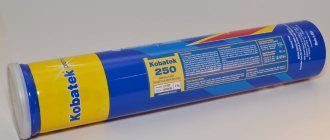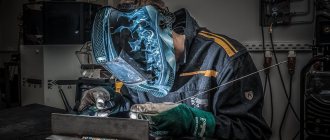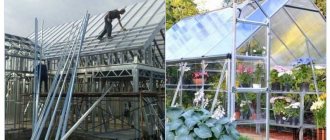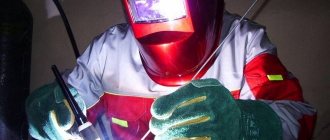What is the difficulty of welding aluminum
Since aluminum does not occur in completely pure form and reacts almost immediately with oxygen, a particular difficulty is the difference in temperature at which the chemical element itself and its accompanying oxide begin to melt.
More precisely, the temperature at which aluminum transitions into the liquid state is 660 C, while the oxide is 2043 C. Boiling point
- Formation of an oxide film, which can be removed mechanically using special grinding devices and sandpaper;
- Instability of aluminum under the influence of elevated temperatures. That is, the use of additional funds can get rid of increased fluidity. For example, special substrates are used to remove heat and direct it only to those areas where arc formation is required;
- Disturbances of the alloy surface. Due to the presence of hydrogen in the alloy and its further release during the heating process, the surface of the metal is often covered with pores and cracks;
- A change in color is a sign that the metal is overheated. As mentioned earlier, the melting point of aluminum is quite low. Consequently, many people make mistakes by overheating the metal. This occurs due to the fact that during the welding process the specialist is wearing a mask, which does not fully reflect the color changes in the environment.
Useful tips
- Welding must be done with direct current with reverse polarity. Is it possible to weld aluminum with alternating current? It is possible, provided that the oscillator and ballast rheostat are used.
- Aluminum cooks best at a temperature of 18 – 22 degrees Celsius and humidity within 70%
- Surfaces must not be cleaned with sandpaper or abrasives.
- Aluminum alloys should be strengthened by cold hardening before electric welding. In industrial conditions, the aluminum coating can be up to 40% of its volume; in domestic conditions, a much thinner layer should be formed.
- To avoid hot cracks, the surfaces must be heated before welding.
- To learn how to weld without craters, first practice on unnecessary pieces of metal. Without turning off the arc, it is necessary to weld in the opposite direction. When welding the crater, form a kind of dome over it, and during cooling, a crack will not form in this place.
- The ejection speed of aluminum wire when using a semi-automatic machine should be 15-20% higher than that of analogues made of ferrous metals.
- Before welding aluminum with an electrode, do not forget to calcinate the consumable material, since it is very hygroscopic.
- If the arc breaks when welding with a consumable electrode, then the next seam should overlap the previous one by about 1 cm. Before continuing work, remove the slag crust from the electrode and crater.
Advantages and disadvantages
As mentioned earlier, welding aluminum is not an easy task and requires a certain skill and knowledge. However, this type of work is still in demand. The only explanation for this is the quality of manufactured parts and structures, despite belonging to the group of light metals.
Moreover, aluminum is so highly valued in industry that almost any tool necessarily includes this substance.
The advantages of cooking include the following:
- This process does not require much time, and the product of your activity can be seen a few minutes after the end of welding;
- This type of work is considered budget-friendly because it does not require the master to have any special equipment;
- Lack of a scale assessing the quality of the resulting seam;
- The result is a strong, seamless seam.
The disadvantages include the following:
- Despite the lack of criteria and requirements, the seam is still of poor quality;
- It is difficult to follow all the TB rules;
- From time to time, a specialist is faced with a problem in choosing auxiliary materials.
How to prepare metal for welding
Regardless of the conditions in which aluminum parts are welded - industrial or domestic, it is necessary to carefully prepare the edges of these parts. Such preparation is as follows.
- The surfaces of the parts to be welded (as well as the filler material) are cleaned of dirt, oil and grease. To degrease surfaces, they are treated with white spirit, acetone, aviation gasoline and any other solvent.
- Preparation also includes cutting the edges of the parts to be welded, which is performed if necessary. If welding of parts made of this metal is not carried out using coated electrodes, then the edges should be cut when the thickness of the parts being joined exceeds 4 mm. If electrodes are used for welding, then edge cutting is performed when the thickness of the parts exceeds 20 mm. If aluminum sheets with a thickness not exceeding 1.5 mm are to be welded, then their ends are flanged before making the connection.
- The oxide film must be removed from the surface of parts made of this metal before welding. For this procedure, a file or brush with stainless steel bristles is used, with the help of which the oxide film is removed from the edges of the workpieces being joined (25–30 mm wide).
Treatment of the welding site with a penetrating compound in order to identify defects and determine the location of the seam
Often, when welding aluminum at home, chemicals are used to remove the oxide film: caustic soda, gasoline. If the edges of the parts to be joined are treated with caustic soda, after such treatment it is necessary to rinse them with running water.
Aluminum welding methods
It is recommended to use several methods for welding aluminum, which are time-tested and popular in certain circles.
These include:
- Submerged arc welding. This material is used to protect joints from oxidation.
- Welding under the influence of gases. Since in this case it is almost impossible to see how aluminum changes color, preliminary training is required to carry out high-quality welding.
- Welding using laser. Laser radiation is used to connect two elements. This in turn promotes melting and forms a nice, smooth joint line.
- Welding using contacts. In this method, two connection methods are appropriate - linear and point. The contact method is good only for fastening sheets;
Welding by increased friction of two elements: this process cannot be called easy; available tools will not be enough depending on the level of complexity of the work.
- Special equipment with a rotating nozzle is required.
- Due to rotation, the aluminum begins to heat up and subsequently melt, after which it is connected to the desired element.
- At home, it is appropriate to use an angle grinder.
Cooking process
To successfully carry out the welding procedure, the following steps must be followed:
- We secure the parts using a vice or, if convenient, a clamp.
- We connect the minus to the bottom part, the plus to the electrode.
- Set the current to 100 A.
- We cook on a short arc, although if you are unaccustomed to catching it it can be quite difficult. But when you get used to it, you will be able to hold it quite confidently.
- When welding is completed, beat off the scale with a hammer and clean it with a brush.
Preparation of material
To perform proper welding, it is worth preparing the edges of the part or structure that will have to be melted. This event can be carried out both at home and at the factory.
Preparation includes:
- High-quality cleaning of the metal working surface from dirt and degreasing. To carry out the latter, you will need a small amount of acetone or gasoline;
- When welding thin sheets of aluminum, they must be properly processed;
- While preparing, you can worry about cutting apart already welded parts;
- Before starting work, the entire part must be cleaned of oxide film. To do this you will need a stiff brush. You can clean it by resorting to special solvents.
Let's sum it up
From the above, the following conclusions can be drawn:
- the method that I describe in this material is a little more labor-intensive than the traditional one, so you need to get used to it a little, but nothing critical;
- you can do without argon, there’s nothing wrong with that, the seam will come out exactly as strong;
- prepare more scrap so that you can practice on it before starting finishing work;
- movements must be faster than with conventional welding in order to obtain a truly high-quality result;
- Be sure to prepare the surface for welding in advance so that later it will turn out more firmly and accurately.
When using materials from thebestvideo.ru, a link to the source is required.
Necessary equipment
It is logical that to carry out work of this kind, the use of equipment is mandatory. First of all, it is necessary to ensure suitable conditions and prevent the occurrence of traumatic situations.
Moreover, it is necessary that this equipment helps control the energy transformation process.
For welding using gas, you will need an element with a gas supply, a cylinder with the necessary gas, a reducer and gas hoses.
How to make a welding machine yourself?
The ideal device is one that will operate on an argon basis. It is the simplest device for electrode welding. At the same time, it is also a ballast for adjusting the strength of the welding current and an oscillator for igniting the arc. To make this device with your own hands, you will need some components, the main one of which is a transformer. For beginners in this business, it is highly advisable to use a ready-made transformer, since when winding the windings, the required material should be selected in accordance with the recommendations. In addition to the winding, it will be necessary to manufacture a rectifier, which will be constantly exposed to voltage during operation.
Safety precautions
This type of activity belongs to the group of trauma-hazardous processes. Therefore, you should strictly follow the prescribed rules to avoid causing harm to others.
It should be remembered that:
- The specialist must wear: a special suit, a mask, thick gloves, shoes with rubber soles;
- The electrical circuit must be isolated and inaccessible;
- Welding can only be carried out in clean areas. It is prohibited to carry out work in the presence of flammable objects;
- The work area must have good ventilation to avoid gas poisoning.
General principle
In general, welding will be carried out on the same principle as arc welding, but there are a few technical points that you should remember:
- welding is carried out with a short arc;
- welding current should ideally reach 70–100 A;
- The electron angle during cooking should be maintained at approximately 90 degrees;
- The electrode burns three times faster than during conventional welding of, for example, steel.
Aluminum welding photo
What is the transformer made of?
In general, the transformer will consist of the following parts:
Welding transformer diagram.
- Transformer housing. Before using it, you must make sure that the housing is grounded. The ground cable must have a cross-section of at least 0.25 cm and be connected to the terminal that supplies the pulse to the working surface of the welding machine. The transformer itself must be installed on an insulating surface during operation. A stand made of duralumin (no more than 0.03 cm thick) or textolite is best suited for these purposes.
- Clamp (collet).
- Handle made of steel rod.
- Magnetic core. The essence of his work is initially to create a closed path for the magnetic flux, which will have the least magnetic resistance. That is why the magnetic core is made from those materials that do not lose their magnetic penetration properties in alternating magnetic fields. Such materials include alloys of iron and nickel or alloys of iron, nickel and cobalt.
- Lever.
- Eye bolt.
- Scale.
- Transformer cover made of cast iron or steel.
- Vertical screw.
- Lead nut for vertical screw.
- Windings Conducted in two stages. The primary winding of the transformer should consist of 250-600 turns. Secondary - from 60 to 75 turns. It is advisable to make it from a copper busbar with a cross-section of at least 0.35 cm in diameter. Winding should only be done along an insulated rod in the same direction. Each subsequent step of the winding must be insulated using fiberglass or a similar type of insulator. Each winding terminal is tinned and labeled. And a cambric is attached to each end of the network part.
- Rectifier. Its function is to convert alternating current into direct current.
- Electrodes. For argon arc welding, it is recommended to use tungsten electrodes, since tungsten can easily withstand direct current of direct and reverse polarity or alternating current. During operation, the electrode must be brought as close as possible to the base of the part. Using this technology, the resulting arc will have small parameters, which is necessary when welding aluminum. The electrode should protrude 2-5 mm from the burner body, and a ceramic nozzle should be placed around it.
- Oscillator. Its action is to deliver high-frequency and high-voltage pulses.
Semi-automatic aluminum welding scheme.
Another necessary item is a burner. A clamp (collet) with a diameter of 0.2 cm is selected. Next, a copper tube with a diameter of 0.6 cm, which will be responsible for supplying gas (in this case, argon) and voltage to the electrode, should be firmly soldered to the opposite direction of the clamp. High temperatures should be used when soldering the tube.
To the other end of the burner it is necessary to attach a tube made of ceramic or quartz, 5 cm long and 0.8 cm in diameter, which will perform the working function. Care must be taken to ensure that the tube remains mobile and can be removed. Because sometimes it will be necessary to redirect the wire. An arc-shaped electrode will be installed in the middle of the tube.
The holding tube must be covered with insulating material. It is best to use fiberglass for this. It needs to be wrapped around the tube in several layers, using silicone sealants between them. After insulation, a switch is installed to the tube.
The burner itself is connected to the gas cylinder using a tube (with a diameter of 0.6 cm to 0.8 cm), and two additional wires are connected, one of which runs from the valve to the switch on the holder tube, the second is intended for voltage in the transformer. The gas supply itself occurs approximately 20 seconds before the start of the welding process.
Butt method
When using this cold welding method, aluminum parts are connected by their end parts, which are first thoroughly cleaned and degreased. In order to make a connection using this method, the workpieces are fixed in special jaws with a small release of the end parts, which will be subject to compression. After the parts are securely fixed, axial pressure is applied to the clamping jaws, which compresses the end parts of the workpieces being connected, which is accompanied by the formation of a reliable permanent connection.
Scheme of butt cold deformation welding
This cold welding method, despite its simplicity, has a number of significant disadvantages and limitations in application.
- The dimensions of the clamping devices used to perform such welding limit the length of the joint formed.
- When aluminum parts are compressed, not only the ends being connected are subjected to plastic deformation, but also the part that is clamped in the jaws.
- After obtaining a permanent connection, the workpieces are quite difficult to remove from the clamping jaws.
Advantages of polyurethane adhesives for aluminum
The adhesive compositions based on polyurethane presented in the assortment of modern manufacturers have the following important qualities:
- High strength;
- Wide temperature range of joint operation (from +30 to -80° C);
- Resistance to corrosion of any type;
- Fast hardening;
- Long service life;
- Resistance to static and dynamic loads.
Using polyurethane-based adhesives, aluminum can be combined not only with the same aluminum, but also with other materials. Products on the market are excellent at bonding this metal to steel, polymer materials, and even glass and stone.
It is widely believed that it is impossible to securely connect two aluminum parts without welding or fasteners. This is not so - the use of polyurethane compounds in aviation and shipbuilding suggests that with the help of modern products it is possible to create reliable and durable joints in highly critical products.
krepcom.ru











